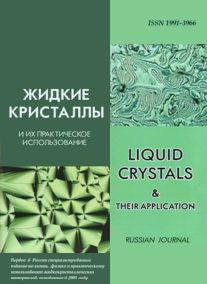|

|
Liquid Crystals and their Application
Russian Journal Zhidkie kristally i ikh prakticheskoe ispol'zovanie Жидкие кристаллы и их практическое использование |

|
|

|

|
|
|
Menu

|
|
|
|
|
Zhidk. krist. ikh prakt. ispol'z. = Liq. Cryst. and their Appl., 2019, 19 (2), 15—24.
DOI: 10.18083/LCAppl.2019.2.15 |

|
|
Quantum-Chemical Study of Liquid Crystalline Polymers for Development of Optoelectronic Materials with Semiconductor Quantum Dots
|
K. A. Romanova1, A. V. Kremleva2, Yu. G. Galyametdinov1
|
Author affiliations
1Kazan National Research Technological University,
68 Karl Marx St., Kazan, 420015, Russia
E-mail: ksenuya@mail.ru
2Technical University of Munich,
4 Lichtenbergstrasse St., Garching, 85748, Germany
|
|
Abstract
Combination of liquid-crystalline polymers with semiconductor quantum dots possessing remarkable optical properties is the way to creation of efficient optical materials with variable spectral characteristics. This way can be fulfilled due to stabilization, localization and organization of the used quantum dots. The present study reports the results on quantum-chemical simulation of structural and photophysical properties of some liquid-crystalline polymers that are used for development of optoelectronics devices containing quantum dots. The modeling of interaction of studied polymers with the surface of cadmium selenide by the density functional theory was performed. It revealed the influence of functional groups of interacting liquid-crystalline polymer on the energy of the corresponding donor-acceptor bond. The difference between geometrical parameters in the bulk and on the surface of cadmium selenide was established, which indicates a deviation of the surface morphology from the internal structure of the substance. It has been established that liquid-crystalline polymers can form strong bonds with the surface cadmium atoms of cadmium selenide and act as passivating surface agents, that can stabilize the physicochemical properties, shape and size of cadmium selenide quantum dots. According to the results of quantum-chemical simulation it is been established that polymers with nitrile groups are capable of forming stronger bonds with the cadmium selenide surface.
Keywords: liquid-crystalline polymers, cadmium selenide, excited states, optoelectronic devices, quantum-chemical simulation, density functional theory
|
|
|
|
|
|




